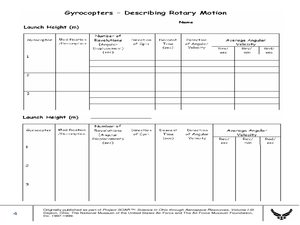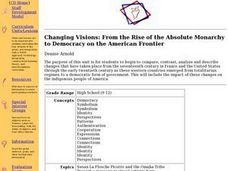Curated OER
Sow the Seeds of Victory! Posters from the Food Administration During World War I
Young scholars engage in a class analysis of posters, responding to each of the worksheet questions. They identify the similarities and differences between the posters.
Curated OER
Gyrocopter - Describing Rotary Motion
Learners calculate angular displacement, velocity and acceleration of gyrocopters. In this physics lesson, students compare data taken from 3 different gyrocopters. They explain how differences in construction material affect rates of...
Curated OER
Introduction to the Blues
Students learn the basic elements of blues and different lyric structures.
Curated OER
Testing the Hypothesis
Middle schoolers create and conduct various experiments to determine the origin of a family artifact, and then determine whether their results were successful. Students summarize their results and evaluate whether their hypotheses were...
Curated OER
Excavating the Past
Young scholars discover how palaeontologists conduct a dig for fossils and how they interpret the age of the fossils. In small groups, they prepare a "dig site" consisting of bones, rocks and soil layered in a cardboard box. They switch...
Curated OER
Civil Rights Heroes
Learners explore the actions of people involved in the Civil Rights Movement. They explore the reasons for the movement and its successes and failures, and explain the sacrifices made by those who participated in the movement.
Curated OER
Is Capitalism Good for the Poor? | No More Slide Rules – The Costs and Benefits of Innovation
Students brainstorm a list of the benefits that Americans at all levels of society have enjoyed as a result of innovations in rail transportation/computers/microprocessors. They write a response from President Jackson to Martin Van Buren...
Curated OER
Rocket Physics
Young scholars investigate the relationship between impulse, momentum, kinetic and potential energy and aerodynamic drag. In this physics lesson, students calculate data taken from launching a rocket. They compare the theoretical and...
Curated OER
From the Rise of the Absolute Monarchy to Democracy on the American Frontier
Young scholars use a teacher-made museum guide with questions that allow them to analyze and compare the patron art of seventeenth-century France with portraits of later periods at the Joslyn Art Museum. Students also read The Little...
Curated OER
Slopes, Hopes, & Speed
Students investigate the sport of skiing through Internet research in this multi-task lesson. They compare and generalize the results of five individuals by using mean, median, and mode.
Curated OER
All's Fair in Sport And Competition
Students design a physical activity contest or game that has no cultural or gender biases which includes an assessment that ranks competitors according to the competitors abilities. They participate in and evaluate the newly designed...
Curated OER
Natural Hazards
Students evaluate the hazards of naturally occurring events. After watching a video concerning safety hazards, students work in groups to discuss the safety issues involved in taking a trip to a mountainous region. Recommendations are...
Curated OER
Calculating the Average Mass of the Newly Discovered Element: Bean
Young scholars determine the average mass of a new element using masses from three isotopes. In this chemistry lesson, students explain what an isotope is. They discuss their importance and uses.
Curated OER
How Can You Study Things You Can’t See Like: Atoms?
Students simulate how scientists studied things they can't see like atoms. In this chemistry lesson, students predict what is inside the numbered obsertainers. They design a way to investigate what's inside without opening it.















